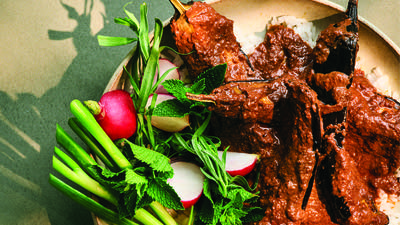
Barton Seaver is an award-winning chef whose work now focuses on sustainability in the fish and seafood industries. He is the author of more than a half-dozen books including the essential American Seafood, a deep dive into the past, present and future of America's emotional and economic relationship with seafood. He talked with Francis Lam specifically about the ways that certain species of fish come in and out of favor with fisherman as well as professional and home cooks. Seaver also shared his recipe for Shrimp al Ajillo from his book Two If By Sea.
Francis Lam: You have this magisterial book on American seafood. I never realized the history of the American taste for seafood was so fascinating. For instance, certain fish became fashionable but then we forgot about them. I'm hoping you can walk us through it a little bit today.
Barton Seaver: American's relationship with seafood is utterly fascinating. It was the first economy this country founded, and upon which we took our first steps toward economic and political freedom. Yes, it was religious freedom that drew the first few settlers here. But it was the economics – a lot drawn off of the backs of cod, and those who fished them in the Northwestern Atlantic – that really provided the first siren call.
But, funny enough, eating seafood has always been somewhat beneath our aspirations. This starts off with a quote from William Bradford, the first governor of Plymouth colony back in 1623. In a plaintive letter back home, he writes, “If ye land afford you bread, and ye sea yeeld you fish, rest you a while contented, God will one day afford you better fare.” There was real trepidation, but also a bias against this, and despite the fact that we came here seeking religious freedom, we didn’t necessarily bring with us a lot of religious tolerance. In the Catholic calendar, there was over 150 fast days that required the devout to abstain from meat. So, seafood was first seen as a food of the Catholics. And from our Protestant beginnings, they were the “others.”
Throughout our history of immigration – which is the story of America – often these new waves of immigrants came from cultures where seafood was a mainstay of their cuisine. And further on, during World War I and World War II, there were campaigns to save meat and eat fish. Americans fed themselves fish to save the products of the land so they could send them to the boys over the sea. Victory Gardens was one means to inspire the citizenry, but seafood also became a food, an asset, to victory. The problem with that though is that once the seasoning of patriotism was removed with the clanging bells of armistice, our preference for seafood again diminished. So there’s been this history of seafood being seen as a penance, or something you do for sacrifice, and that’s also borne out of the fact that we’ve only ever eaten about fifteen pounds of seafood per person per year in this country.
FL: Compared to chicken?
BS: Over 200 or 225 pounds of beef, pork, chicken, lamb, turkey. It’s just not our preferred food.
 Barton Seaver
Photo: Michael Piazza
Barton Seaver
Photo: Michael Piazza
FL: It’s funny you say that. It is obviously cultural. I come from a culture that reveres seafood; it’s the highest form of food. And over the years, we still eat 15 pounds per person per year, so that’s a lot of fish, a lot of seafood. And as I understand it in your history, there are definitely fish that become extremely popular through the years. What are some reasons that certain fish might become popular and why do some fish stop being delicious to us?
BS: Well first, when we’re talking about wild fisheries, this is nature. There are fluctuations. Some seafood like bluefish now pares the albatross with widespread disdain. Bluefish was once an incredibly popular, revered, and valuable seafood that just disappeared from the waters. Not necessarily because of overfishing but because of decadal fluctuations in population landmass.
Part of the shifting in preference for seafood is that before the early 1900s, seafood was caught by small boat regional fisheries – with the exception of the North Atlantic Fleet that was catching this abundance of cod. Small boat fleets caught most of the seafood, whether it was the Greek fishery for shrimp, octopus, or even sponge - which they didn’t eat - out of Florida, or the Portuguese coming out of Bedford, in areas a little bit south. The Chinese immigrants that settled along the West Coast brought with them their own preferences in fishing methods and even a boat design called the Chinese junk. During this phase, preference was based on regional availability. But after the early 1900s, technology took over and the diesel engine allowed massive nets to be towed through the water to indiscriminately catch whatever was in its path. The small boat fishery never regained prominence in the fishing economy, and we moved more towards a very limited scope of species.
FL: Some of these individual species have some pretty crazy stories about why they became popular one day and not the next. Can you tell us about tilefish?
BS: Tilefish is pretty awesomely unique in the canon of America’s seafood stories. Tilefish was discovered in the late 1800s by a captain named Captain Kirby who was fishing in deeper waters than was normal, doing an experimental fishery, and up came about 5,000 pounds of tilefish - a fish never before seen. They immediately sent one down to the galley and cooked it up. Everyone present declared it to be one of the finest fish they had ever tasted. This new discovery was brought to the attention to the American public. Captains began targeting it and it became the darling of the culinary scene in America.
Along with tilefire, Patagonian toothfish, also known as Chilean seabass or orange roughy, also suddenly found a new astronomical rise to the top of every menu. But what’s amazing is that three years later an event happened where an inversion of cold water trapped all the tilefish and killed them. And this is a naturally occurring event. Steamships going back and forth from Europe to Boston, all the way down to Norfolk, reported passing through tens of square miles of ocean completely covered in dead tilefish. It was decades before tilefish were seen again in the fisheries, and it was further decades before it was of any abundance. But by the time tilefish returned to market and America’s tables, it had fallen from our graces and we had moved on to new favorites. And tilefish has never gained the popularity it once enjoyed.
 American Seafood by Barton Seaver
American Seafood by Barton Seaver
FL: As you said, there are so many biomass fluctuations and changes of water currents that can cause a population of fish to explode or decrease. But that also gets me thinking about seasonality. Most fish do have seasons, right?
BS: Absolutely. Coming up into spring as we are right now, there’s a lot of attention being paid to seafood. Why? Well, going back to the beginning of this conversation: Lent. This is when most seafood is eaten in America. Lent and right around Christmas. This is when the waters come alive. This is when the waters warm and masses of fish begin make their migration towards shore, often times to spawn, and then to begin their summer-long predatory indulgences that fattens them towards fall. And this is an exciting season, but not necessarily one that offers us the best quality fish.
FL: Right, because they’ve already spent a lot of the fat they built up over the winter.
BS: Exactly. One of my favorite fish, mackerel, which I fish quite a lot in my harbor, has been described in spring as lacking in richness, stale in flavor, and as retched skeletons at their worst.
FL: That’s cold, man.
BS: Their fat content can drop down as low as two percent, whereas in their fattest form, they’re up to over twenty percent fat in that richness and luxuriousness. That’s not to say they’re not worth eating, but then there’s other species that come in to our culinary cannon in the spring that are the pinnacle of things that we celebrate. On the East Coast, we have the stripe bass. Over in the Pacific Northwest, up in Alaska, we have the Copper River salmon, which is American’s most famous branded providence of fish. And that fishery opens up around May fifteenth every year or so. There’s a lot of things in spring to really celebrate. Shad roe and shrimp open up down in the Gulf. There’s a lot there and it only gets better throughout the summer.
Before you go...
Each week, The Splendid Table brings you stories that expand your world view, inspire you to try something new, and show how food connects us all. We rely on your generous support. For as little as $5 a month, you can have a lasting impact on The Splendid Table. And, when you donate, you’ll join a community of like-minded individuals who love good food, good conversation, and kitchen companionship. Show your love for The Splendid Table with a gift today.
Thank you for your support.
Donate today for as little as $5.00 a month. Your gift only takes a few minutes and has a lasting impact on The Splendid Table and you'll be welcomed into The Splendid Table Co-op.




